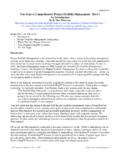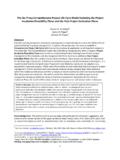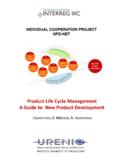Transcription of 2/1/04 The Role of the Project Life Cycle (Life Span) …
1 2/1/04 AEW Services, Vancouver, BC 2003 Email: Role of the Project life Cycle ( life span ) in Project ManagementA literature review by R. Max Wideman(Updated February, 2004.)IntroductionPatel and Morris have stated that"The life Cycle is the only thing that uniquely distinguishes projects from non-projects".1If that is true, then it would be valuable to examine just what role the so-called Project life Cycle plays inthe conduct of Project management . And, moreover, has this changed over the years as we improve ourunderstanding of the complexities of Project , what is the Project life Cycle ? According to the same source"The sequence of phases through which the Project will evolve. It is absolutelyfundamental to the management of projects .. It will significantly affect how the projectis structured. The basic life Cycle follows a common generic sequence: Opportunity,Design & Development, Production, Hand-over, and Post- Project Evaluation.
2 The exactwording varies between industries and organizations. There should be evaluation andapproval points between phases often termed 'gates'."2 How does that make it different from normal operational corporate endeavors? For that we mustunderstand the definition of Project . According to Richard E. Westney: "A Project can be defined as thework required to take an opportunity and convert it into an asset."3 In this sense, both the opportunityand asset are singular, with the implied use being for generating benefit rather than consumed as aresource in normal operational activity over a prolonged Patel and Morris definition refers to "gates" between phases. Another name for "gates" ismilestones, albeit "major milestones". Since scheduling also involves milestones, how is a Project lifecycle different from a Project schedule? Once again there are various definitions, but essentially aproject schedule is a display of "the planned dates for performing activities and the planned dates formeeting milestones.
3 "4 The two are clearly very similar, but the essence of a Project schedule is toprovide specific activity dates while the Project life Cycle is in the nature of a strategic plan displayingsequence , while we are at it, what about that word " Cycle "? It is true that Cycle implies a period of time for aseries of events, but the essential feature of a Cycle is that it is repeated. This is not the case with aproject, except in certain special cases such as linear projects like pipe laying, road building or high-riseconstruction, where a sequence of activities may be repeated at the working level during the executionphase. So the term appears to be inappropriate. Therefore, a better term would be " Project life span ".Historical perspectiveThe concept of a "sequence of phases", or sequential periods of time for an undertaking is not a new Role of the Project life Cycle in Project management Page 2 of 22 AEW Services, Vancouver, BC 2003, 2004 Email: than 2,500 years ago, the famous Chinese philosopher, Confucius, expressed this sentiment.
4 "In allthings, success depends upon previous preparation and without such preparation there is sure to befailure." In modern parlance, this elementary observation translates into a simple two-step sequence:"Plan before doing", or the more popular exhortation "Plan Your Work, Work Your Plan!" So, here wehave the genesis of the Project life of the earliest references to a planned sequence that I can find is from the Institution of CivilEngineers (ICE) Post War National Development Report published in In this report, the ICErecognized the need for a systematic approach to planning public works projects by pointing out that:"In order to carry out work efficiently, it is essential that a scheme of operations be firstdecided by those directly responsible for the execution .. With such planning the workcan be broken down into a series of operations and an orderly sequence or programme ofexecution evolved.
5 Without a Programme the execution can only be haphazard anddisorderly .. The drawing up of a Programme at the beginning of the work does notmean, of course, that it is drawn up once and for all and cannot be changed. The exactreverse is the case .."It is true that this might be interpreted as a reference to scheduling, known as programming in the , the reference to "scheme of operations" also permits a strategic intent, especially asscheduling, per se, did not come into its own until some years fact, according to Wilemon:"In the late 1950s, for example, considerable attention was focused on the Navy's use ofproject management in the development of the Polaris program. A few years later, NASA received the attention of practitioners and academicians for the advances it made inproject management in administering the large, complex Apollo program."6 Actually, the "attention of practitioners and academicians" was focused mainly on the critical pathmethod (CPM) for scheduling a complex set of Project activities, especially with the emergence ofmainframe computer Project management focused textsOne of the earliest comprehensive texts on Project management is Archibald's book: Managing High-Technology Programs and Projects (1976).
6 In it, Archibald explains the Project life span as follows:The Project life Cycle has identifiable start and end points, which can be associated with atime scale. A Project passes through several distinct phases as it matures, as illustrated inFigure The life Cycle includes all phases from point of inception to final terminationof the Project . The interfaces between phases are rarely clearly separated, except in caseswhere proposal acceptance of formal authorization to proceed separates the two phases."7 Figure is actually a table, which lists five types of Project and shows the typical activities for each ineach of six phases. The six phases are sequentially: 1 - Concept; 2 - Definition; 3 - Design; 4 -Development; 5 - Application; and 6 - Post goes on to sayThe Role of the Project life Cycle in Project management Page 3 of 22 AEW Services, Vancouver, BC 2003, 2004 Email: Project Character Changes in Each life - Cycle PhaseIn each succeeding phase of a Project new and different intermediate products (results)are created, with the product of one phase forming a major input to the next phase.
7 Illustrates the overall process. The rate of expenditure of resources changes, usuallyincreasing with succeeding phases until a rapid decrease at completion. The people,skills, organizations, and other resources involved in the Project change in each life cyclephase. Major review of the entire Project occurs at the end of each phase, resulting inauthorization to proceed with the next phase, cancellation of the Project , or repetition of aprevious phase."8 Archibald's Figure is shown in Figure 1 1: Archibald's Project life SpanThe Project management Institute ("PMI"), a US based not-for-profit organization dedicated to projectmanagement was launched in Pennsylvania in 1969. Its first formal textbook was "The Implementationof Project management " edited by Dr. Linn Stuckenbruck (1981). In it, Stuckenbruck describes theproject life Cycle as follows"The Project life CycleA Project consists of sequential phases as shown in Figure 1-1.
8 These phases areextremely useful in planning a Project since they provide a framework for budgeting,manpower and resource allocation, and for scheduling Project milestones and projectreviews. The method of division of a Project into phases may differ somewhat fromindustry to industry, and from product to product, but the phases shown in the Figure arebasic." 9 Stuckenbruck's Figure 1-1 is shown in Figure Role of the Project life Cycle in Project management Page 4 of 22 AEW Services, Vancouver, BC 2003, 2004 Email: 2: Stuckenbruck's government system life spanStuckenbruck also tabulates what must be done in each phase by both top management and, as theproject matures, by the Project manager as shown in Table 1 Concept orInitiationGrowth orOrganizationProduction orOperationalShut-downManagement decidesthat a Project is establishesgoals and estimates ofresources "sells" theorganization on theneed for makes plan andschedule for operationalphase objectives, tasks(WBS), and team major work of theproject accomplished( , design,development,construction,producti on, testing, siteactivation, etc.)
9 Project , resources,and commitmentstransferred to 1: Stuckenbruck's Project phase actionsThe Role of the Project life Cycle in Project management Page 5 of 22 AEW Services, Vancouver, BC 2003, 2004 Email: this table we see clear signs of the evolutionary nature of a Project and the purpose of establishing aproject life span model. Stuckenbruck then establishes a second purpose by observing"This book is primarily concerned with the actions that take place during implementationof a Project , which is a combination of the concept or initiation phase and the growth ororganization phase. It is often useful to divide the Project into phases as shown in Figure1-2. This scheme of phases fits projects such as construction, and by plotting the phasesversus total effort, a very clear picture can be obtained as to where the money goes."Stuckenbruck's Figure 1-2 is shown in Figure the different interpretations of "implementation" we may question Stuckenbruck's use of thisword.
10 Is it the "execution phase", or is it the launching of the entire Project ? The contents of Table 1suggest the latter. While on the subject of word meanings, program management and projectmanagement were often considered back then to be one and the same, as Stuckenbruck states "For thepurposes of this book, the words Project and program are considered to be synonymous."10 Figure 3: Stuckenbruck's effort-loaded life spanPMI followed this publication with a series of monographs or mini handbooks. One, by Cavendish andMartin, described the relationship between contracting and the Project life span , that is, the life spanfrom a general contractor's perspective. The authors point out that for the contractor, the Project startswith contract award and hence coincides with the implementation phase. This is an important pointbecause many diehard Project people, those from the contracting fraternity, do not consider that thereis a "real" Project to manage until it exists under a contract.







